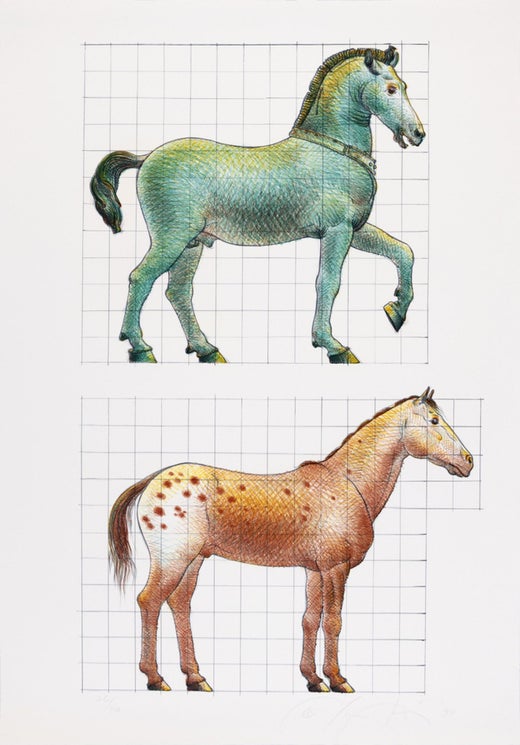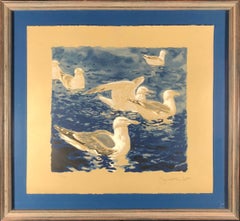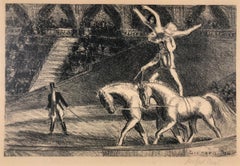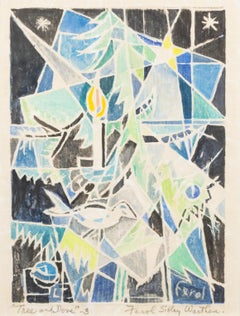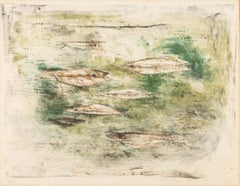Video Loading
Want more images or videos?
Request additional images or videos from the seller
1 of 12
Luis JiménezStudy for Los Lagartos1998
1998
$5,500List Price
About the Item
- Creator:Luis Jiménez (1940-2007, American)
- Creation Year:1998
- Dimensions:Height: 15 in (38.1 cm)Width: 21.75 in (55.25 cm)
- Medium:
- Movement & Style:
- Period:
- Condition:
- Gallery Location:Missouri, MO
- Reference Number:1stDibs: LU747314558752
Luis Jiménez
Born in El Paso, Texas, he worked at his father's neon sign studio as a child, which prepared him to make public art. He studied art and architecture at the University of Texas in Austin and El Paso, earning a bachelor's degree in 1964. He moved to New York City in 1966 after completing his post-graduate work at Ciudad Universitaria, Mexico City, D.F. He became an accomplished artist and taught art at the University of Arizona and later the University of Houston. As a sculptor, Jiménez was known for his large polychromed fiberglass sculptures, often of Southwestern and Hispanic themes. His works were often controversial. They are eminently recognizable due to their themes, his original sculptural style, and the colorful, undulating surfaces the artist employed. The finish of his sculptures had more in common with commercial products than with conventional fine art sculptures. Man on Fire (1969) at the Smithsonian American Art Museum in 2023 Jiménez was influenced by the murals of José Clemente Orozco and Diego Rivera. He was very much a contemporary artist whose roots were in pop art, as much as they were in both the modernism of the Mexican muralists and the regionalism of Thomas Hart Benton and Grant Wood. Heroic sculptures were Jiménez's forte, championing the common man in his work. By working in his father's shop on neon signs and sculptures, he was brought in contact with popular culture, which also included lowrider car culture. The brightly painted fiberglass bodywork, often accented with glitter, served as a particularly relevant artistic influence.[5] While he is best known as a sculptor, Jiménez also made remarkable color lithographs and color drawings in pencil, pastel, and oil stick. He made preparatory drawings for his sculptures, some of which were very large. Most of his sculptures were made of fiberglass, which were cast in a mold, after which they were painted with multiple layers of paint and coated with epoxy. One art expert has noted, "There was no surface on any Luis Jiménez sculpture that was ever any less than six different colors, each airbrushed separately adding a slightly different tone." Jiménez would also often use flake, that glittery quality often seen on lowrider cars, in his paint. In 1993, Jiménez was a recipient of the New Mexico Governor's Awards for Excellence in the Arts. In 1998 he received a Distinguished Alumni award from the University of Texas in recognition of his artwork.
About the Seller
5.0
Vetted Professional Seller
Every seller passes strict standards for authenticity and reliability
Established in 1970
1stDibs seller since 2017
156 sales on 1stDibs
Typical response time: Several days
Authenticity Guarantee
In the unlikely event there’s an issue with an item’s authenticity, contact us within 1 year for a full refund. DetailsMoney-Back Guarantee
If your item is not as described, is damaged in transit, or does not arrive, contact us within 7 days for a full refund. Details24-Hour Cancellation
You have a 24-hour grace period in which to reconsider your purchase, with no questions asked.Vetted Professional Sellers
Our world-class sellers must adhere to strict standards for service and quality, maintaining the integrity of our listings.Price-Match Guarantee
If you find that a seller listed the same item for a lower price elsewhere, we’ll match it.Trusted Global Delivery
Our best-in-class carrier network provides specialized shipping options worldwide, including custom delivery.You May Also Like
Animal Kingdom (Magnificent Jungle Cats)
By Louise Nevelson
Located in Fairlawn, OH
Animal Kingdom (Magnificent Jungle Cats)
Etching, 1953-1955
Signed and titled in pencil by the artist (see photos)
Annotated: "First Proof" (see photo)
Estate stamp verso (see photo)...
Category
1950s American Modern Prints and Multiples
Materials
Etching
Mouse and Chair
By Donald Saff
Located in Middletown, NY
Etching with aquatint on white wove paper with a deckle edge, 23 1/2 x 17 1/2 inches (598 x 317 mm); sheet 30 x 22 1/2 (762 x 571 mm), full margins. Signed and numbered 20/50 in penc...
Category
Late 20th Century American Modern Animal Prints
Materials
Handmade Paper, Etching, Aquatint
Head of a Man, Fish and Morning Glory
By Donald Saff
Located in Middletown, NY
Etching with aquatint in colors on white wove paper with a deckle edge, 18 x 15 inches (457 x 381 mm); sheet 30 x 22 1/2 inches (762 x 571 mm), full margins. Signed and numbered 123/...
Category
Late 20th Century American Modern Animal Prints
Materials
Handmade Paper, Etching, Aquatint
Wolfman
By Donald Saff
Located in Middletown, NY
Etching with aquatint on white wove paper with a deckle edge, 23 1/2 x 17 1/2 inches (598 x 317 mm); sheet 30 x 22 1/2 inches (762 x 571 mm), full margins. Signed and numbered 4/10 i...
Category
Late 20th Century American Modern Animal Prints
Materials
Handmade Paper, Etching, Aquatint
Flora
By Donald Saff
Located in Middletown, NY
Etching with aquatint on white wove paper with a deckle edge, 23 1/2 x 17 1/2 inches (598 x 317 mm); sheet 30 x 22 1/2 inches (762 x 571 mm), full margins. Signed and numbered 38/50 ...
Category
Late 20th Century American Modern Animal Prints
Materials
Handmade Paper, Etching, Aquatint
Chaplin and Red Tailed Hawk
By Donald Saff
Located in Middletown, NY
Etching with aquatint on white wove paper with a deckle edge, 23 1/2 x 17 1/2 inches (598 x 317 mm); sheet 30 x 22 1/2 inches (762 x 571 mm), full margins. Signed and numbered 23/50 ...
Category
Late 20th Century American Modern Animal Prints
Materials
Handmade Paper, Etching, Aquatint
Faculty Meeting
Located in San Francisco, CA
This artwork titled "Faculty Meeting" c.1990 in an original etching with intensive hand coloring on B.F.K Rives paper by American artist Kelly Detweiler. It is hand signed, titled and numbered E.V 5/8 in pencil by the artist. The image size is 16 x 15.65 inches, sheet size is 24.35 x 22.25 inches. It is in excellent condition, the colors are fresh and bright, has never been framed.
About the artist:
Born in Twin Falls Idaho, his family immediately moved to Monte Vista, Colorado where he lived until age 12. Many of the idyllic memories of this childhood inform his imagination and enter into his work. Moving from a very small farming and ranching community, he was plunged into the crazed consumer culture of Southern California. He lived in La Mesa, California and watched as the entire face of America changed with Vietnam, rampant divorce, and then the summer of love. He attended Grossmont College and immersed himself in art. Seeking to escape the drug crazed beach culture, he set out for northern California.
Kelly attended Cal State University at Hayward where he studied with Mel Ramos, Raymond Saunders, Harold Schlotzhauer, Misch Kohn, Kenji Nanao and Clayton Bailey...
Category
Late 20th Century American Modern Animal Prints
Materials
Etching
To the Sea
By Jack Coughlin 1
Located in New Orleans, LA
Born in Greenwich, Connecticut, Jack Coughlin studied at the Rhode Island School of Design in Providence and the Art Students League of New York. He is b...
Category
1960s American Modern Animal Prints
Materials
Aquatint
Ethel Magafan “Corralled Horse” 1940s WPA-Era Modernist Etching, Artist’s Proof
By Ethel Magafan
Located in Denver, CO
Corralled Horse is a rare WPA-era modernist etching by acclaimed American artist Ethel Magafan, created in the 1940s. This artist’s proof depicts a lone dark horse within a wooden co...
Category
1940s American Modern Figurative Prints
Materials
Etching
Black Bull
By Gabor F. Peterdi
Located in Long Island City, NY
Artist: Gabor Peterdi, Hungarian (1915 - 2001)
Title: Black Bull
Year: 1962
Medium: Etching, signed, titled and numbered in pencil
Edition: HC 10
Image Size...
Category
1960s American Modern Animal Prints
Materials
Etching
More From This Seller
View AllHerring Gulls
By Jamie Wyeth
Located in Missouri, MO
Jamie Wyeth
"Herring Gulls" 1978
Color Lithograph
Signed Lower Right
Numbered Lower Left 149/300
Born in 1946, James Browning Wyeth came of age when the meaning of patriotism was clouded by the traumas of the Vietnam War and the scandals of Watergate. Working in an era of turmoil and questioning of governmental authority, he did art that encompassed both marching off to war and marching in protest.
One of James's early masterworks, Draft Age (1965) depicts a childhood friend as a defiant Vietnam-era teenager resplendent in dark sunglasses and black leather jacket in a suitably insouciant pose.
Two years later Wyeth painstakingly composed a haunting, posthumous Portrait of President John F. Kennedy (1967) that seems to catch the martyred Chief Executive in a moment of agonized indecision. As Wyeth Center curator Lauren Raye Smith points out, Wyeth "did not deify the slain president, [but] on the contrary made him seem almost too human."
Based on hours of study and sketching of JFK's brothers Robert and Edward -
documented by insightful studies in the exhibition - the final, pensive portrait seemed too realistic to family members and friends. "His brother Robert," writes Smith in the exhibition catalogue, "reportedly felt uneasy about this depiction, and said it reminded him of the President during the Bay of Pigs invasion."
In spite of these misgivings, James's JFK likeness has been reproduced frequently and is one of the highlights of this show. The poignancy, appeal and perceptiveness of this portrait, painted when the youngest Wyeth was 21 years old, makes one wish he would do more portraits of important public figures.
James himself feels he is at his best painting people he knows well, as exemplified by his vibrant Portrait of Jean Kennedy Smith (1972), which captures the vitality of the slain President's handsome sister.
He did paint a portrait of Jimmy Carter for the January 1977 man-of-the-year cover of Time magazine, showing the casually dressed President-elect as a straightforward character posed under a flag-draped water tower next to the family peanut plant in Plains, Ga. James recalls that Carter had one Secret Service agent guarding him as he posed outdoors, a far cry from the protection our Chief Executives require today.
As a participating artist in the "Eyewitness to Space" program organized by the National Aeronautics and Space Administration in collaboration with the National Gallery of Art in the late 1960s, Wyeth deftly recorded in a series of watercolors his eyewitness observations of dramatic spacecraft launchings and more mundane scenes associated with the space program.
Commissioned by Harper's Magazine to cover the 1974 congressional hearings and trials of Watergate figures, James Wyeth executed a series of perceptive and now evocative sketches that recall those dark chapters in our history. Memorable images include a scowling John Ehrlichman, a hollow-eyed Bob Haldeman, an owlish Charles Colson, a focused Congressman Peter Rodino, a grim visaged Father/ Congressman Robert Drinan, and vignettes of the press and various courtroom activities. An 11-by-14-inch pencil sketch of the unflappable Judge John Sirica is especially well done. These "images are powerful as historical records," observes Smith, "and as lyrically journalistic impressions of events that changed the nation forever."
Wyeth's sketch of early-morning crowds lined up outside the Supreme Court
building hoping to hear the Watergate case, with the ubiquitous TV cameramen looking on, is reminiscent of recent scenes as the high court grappled with the Bush-Gore contest.
The Wyeth family penchant for whimsy and enigmatic images is evident in Islanders (1990), showing two of James's friends, wearing goofy hats, sitting on the porch of a small Monhegan Island (Me.) cottage draped with a large American flag. Mixing the serious symbolism of Old Glory with the irreverent appearance of the two men, James has created a puzzling but interesting composition.
Painting White House...
Category
1970s American Modern Animal Prints
Materials
Lithograph, Paper
Price Upon Request
Bareback Act, Old Hippodrome
By Gifford Beal
Located in Missouri, MO
Bareback Act, Old Hippodrome
By Gifford Beal (1879-1956)
Signed Lower Right
Unframed: 6.5" x 9.5"
Framed: 17.5" x 20"
Gifford Beal, painter, etcher, muralist, and teacher, was born in New York City in 1879. The son of landscape painter William Reynolds Beal, Gifford Beal began studying at William Merritt Chase's Shinnecock School of Art (the first established school of plein air painting in America) at the age of thirteen, when he accompanied his older brother, Reynolds, to summer classes. He remained a pupil of Chase's for ten years also studying with him in New York City at the artist's private studio in the Tenth Street Studio Building. Later at his father's behest, he attended Princeton University from 1896 to 1900 while still continuing his lessons with Chase. Upon graduation from Princeton he took classes at the Art Students' League, studying with impressionist landscape painter Henry Ward Ranger and Boston academic painter Frank Vincent DuMond. He ended up as President of the Art Students League for fourteen years, "a distinction unsurpassed by any other artist."
His student days were spent entirely in this country. "Given the opportunity to visit Paris en route to England in 1908, he chose to avoid it" he stated, "I didn't trust myself with the delightful life in ParisIt all sounded so fascinating and easy and loose." His subjects were predominately American, and it has been said stylistically "his art is completely American." Gifford achieved early recognition in the New York Art World.
He became an associate member of the National Academy of Design in 1908 and was elected to full status of academician in 1914. He was known for garden parties, circuses, landscapes, streets, coasts, flowers and marines. This diversity in subject matter created "no typical or characteristic style to his work."
Beal's style was highly influenced by Chase and Childe Hassam, a long time friend of the Beal family who used to travel "about the countryside with Beal in a car sketching...
Category
20th Century American Modern Animal Prints
Materials
Lithograph
Price Upon Request
Tree and Dove
Located in Missouri, MO
Tree and Dove
Ferol K. Sibley Warthen (American, 1890-1986)
Color Woodblock Print
Edition of 3
6.25 x 4.75 inches
13 x 11.5 inches with frame
Signed Lower Right
Titled Lower Left
Born 1890, Died 1986...
Category
Mid-20th Century American Modern Animal Prints
Materials
Color
Les Poissons
By Zao Wou-Ki
Located in Missouri, MO
Zao Wou-Ki (Chinese, French, 1921-2013)
Les Poissons, 1953
Lithograph
Hand-signed in pencil Lower Right
Hand-numbered 16/55 in pencil Lower Left
18 x 23 1/8 inches
29 x 33 inches wit...
Category
1950s Modern Animal Prints
Materials
Lithograph
$12,500
Le Christ a l'Horloge, Paris (Christ in the Clock)
By Marc Chagall
Located in Missouri, MO
Marc Chagall
"Le Christ a l'Horloge, Paris" (Christ in the Clock) 1957 (M. 196)
Color Lithograph on Arches Wove Paper
Signed in Pencil "Marc Chagall" Lower Right
Initialed "H.C." (Hors Commerce) Lower Left, aside from numbered edition of 90
*Floated in Gold Frame with Linen Matting, UV Plexiglass
Sheet Size: 18 3/4 x 14 3/4 inches (47.5 cm x 38 cm)
Image Size: 9 3/4 x 8 1/2 inches
Framed Size: 28.5 x 24.25 inches
Marc Chagall was a man of keen intelligence, a shrewd observer of the contemporary scene, with a great sympathy for human suffering. He was born on July 7, 1887 in Vitebsk, Russia; his original name was Moishe Shagal (Segal), but when he became a foremost member of the Ecole de Paris, he adopted French citizenship and the French spelling of his name. Vitebsk was a good-sized Russian town of over 60,000, not a shtetl. His father supported a wife and eight children as a worker in a herring-pickling plant.
Sheltered by the Jewish commandment against graven images, the young Chagall never saw so much as a drawing until, one day, he watched a schoolmate copying a magazine illustration. He was ridiculed for his astonishment, but he began copying and improvising from magazines. Both Chagall's parents reluctantly agreed to let him study with Yehuda Pen, a Jewish artist in Vitebsk. Later, in 1906, they allowed their son to study in St. Petersburg, where he was exposed to Russian Iconography and folk art. At that time, Jews could leave the Pale only for business and employment and were required to carry a permit. Chagall, who was in St. Petersburg without a permit, was imprisoned briefly.
His first wife, Bella Rosenfeld, was a product of a rich cultivated and intellectual group of Jews in Vitebsk. Chagall was made commissar for the arts for the area, charged with directing its cultural life and establishing an art school. Russian folklore, peasant life and landscapes persisted in his work all his life. In 1910 a rich patron, a lawyer named Vinaver, staked him to a crucial trip to Paris, where young artists were revolutionizing art. He also sent him a handsome allowance of 125 francs (in those days about $24) each month. Chagall rejected cubism, fauvism and futurism, but remained in Paris. He found a studio near Montparnasse in a famous twelve-sided wooden structure divided into wedge-shaped rooms. Chaim Soutine, a fellow Russian Jew, and Modigliani lived on the same floor. To Chagall's astonishment, he found himself heralded as one of the fathers of surrealism. In 1923, a delegation of Max Ernst, Paul Eluard and Gala (later Salvador Dali's wife) actually knelt before Chagall, begging him to join their ranks. He refused.
To understand Chagall's work, it is necessary to know that he was born a Hasidic Jew, heir to mysticism and a world of the spirit, steeped in Jewish lore and reared in the Yiddish language. The Hasidim had a special feeling for animals, which they tried not to overburden. In the mysterious world of Kabbala and fantastic ancient legends of Chagall's youth, the imaginary was as important as the real. His extraordinary use of color also grew out of his dream world; he did not use color realistically, but for emotional effect and to serve the needs of his design. Most of his favorite themes, though superficially light and trivial, mask dark and somber thoughts. The circus he views as a mirror of life; the crucifixion as a tragic theme, used as a parallel to the historic Jewish condition, but he is perhaps best known for the rapturous lovers he painted all his life. His love of music is a theme that runs through his paintings.
After a brief period in Berlin, Chagall, Bella and their young daughter, Ida, moved to Paris and in 1937 they assumed French citizenship. When France fell, Chagall accepted an invitation from the Museum of Modern Art to immigrate to the United States. He was arrested and imprisoned in Marseilles for a short time, but was still able to immigrate with his family. The Nazi onslaught caught Chagall in Vichy, France, preoccupied with his work. He was loath to leave; his friend Varian Fry rescued him from a police roundup of Jews in Marseille, and packed him, his family and 3500 lbs. of his art works on board a transatlantic ship. The day before he arrived in New York City, June 23, 1941, the Nazis attacked Russia. The United States provided a wartime haven and a climate of liberty for Chagall. In America he spent the war years designing large backdrops for the Ballet.
Bella died suddenly in the United States of a viral infection in September 1944 while summering in upstate New York. He rushed her to a hospital in the Adirondacks, where, hampered by his fragmentary English, they were turned away with the excuse that the hour was too late. The next day she died.
He waited for three years after the war before returning to France. With him went a slender married English girl, Virginia Haggard MacNeil; Chagall fell in love with her and they had a son, David. After seven years she ran off with an indigent photographer. It was an immense blow to Chagall's ego, but soon after, he met Valentine Brodsky, a Russian divorcee designing millinery in London (he called her Fava). She cared for him during the days of his immense fame and glory. They returned to France, to a home and studio in rustic Vence. Chagall loved the country and every day walked through the orchards, terraces, etc. before he went to work.
Chagall died on March 28, 1985 in the south of France. His heirs negotiated an arrangement with the French state allowing them to pay most of their inheritance taxes in works of art. The heirs owed about $30 million to the French government; roughly $23 million of that amount was deemed payable in artworks. Chagall's daughter, Ida and his widow approved the arrangement.
Written and submitted by Jean Ershler Schatz, artist and researcher from Laguna Woods, California.
Sources:
Hannah Grad Goodman in Homage to Chagall in Hadassah Magazine, June 1985
Jack Kroll in Newsweek, April 8, 1985
Andrea Jolles in National Jewish Monthly Magazine, May 1985
Michael Gibson...
Category
1950s Modern Figurative Prints
Materials
Lithograph
Two Snowy Owls
By Roger Tory Peterson
Located in Missouri, MO
Color Lithograph
Image Size: 30 x 19 inches
Framed Size: 40.25 x 29.75 inches
Edition 392/950
Artist Signed and Numbered
Artist and naturalist Roger Tory Peterson...
Category
Late 20th Century Naturalistic Animal Prints
Materials
Lithograph
Price Upon Request
Recently Viewed
View AllMore Ways To Browse
Chromolithograph Eggs
Icelandic Falcon
Le Picador
George Rodrigue Blue Dog Paintings
Jeu De La Cape
New Orleans Jazz Festival
Ori Reisman
Owl Woodcut
Pablo Picasso Le Picador Ii
Pablo Picasso Pigeons
Prang Lithograph
Vintage Forest Service
Audubon Engraving
Camel Cigarette
Eugene Brands
George Rodrigue Canvas
Le Picador Ii
Les Banderilles
